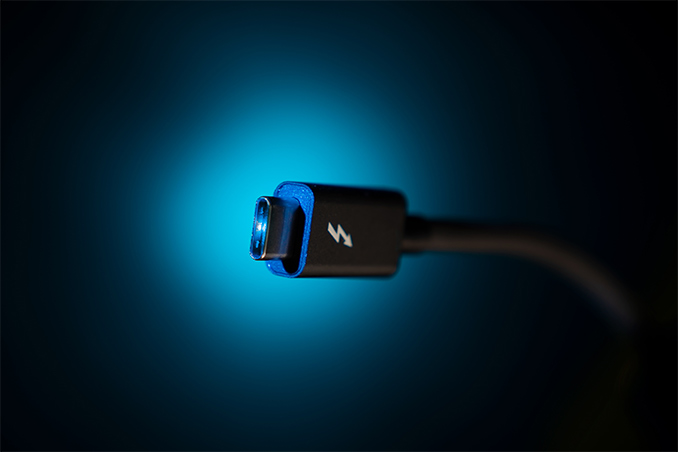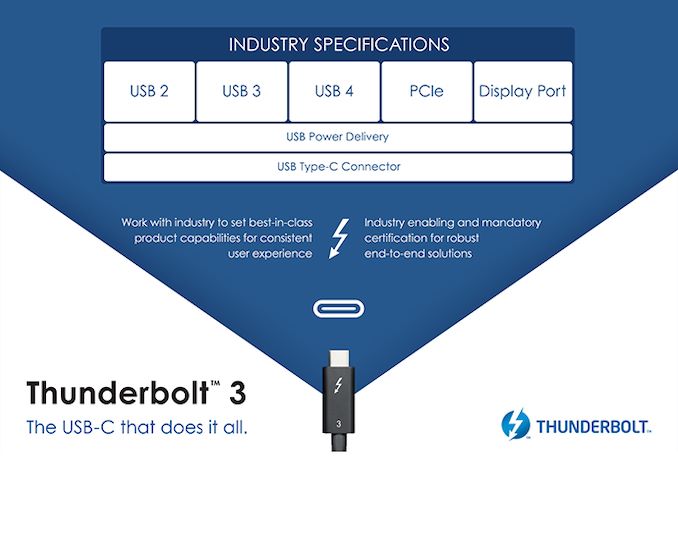USB4 Specification Announced: Adopting Thunderbolt 3 Protocol for 40 Gbps USB
by Anton Shilov on March 4, 2019 1:35 PM EST- Posted in
- Peripherals
- USB-C
- USB
- USB4

The USB Promoter Group has announced the upcoming release of the USB4 specification. The new standard is based on Intel’s Thunderbolt protocol and supports a range of features, including data transfer rates of up to 40 Gbps, display interfaces, and power delivery. The detailed USB4 specification will be published in the middle of 2019.
The USB4 specification will be based on the Thunderbolt protocol that Intel has contributed to the USB Promoter Group. The new interface will use USB Type-C connectors and will maintain backwards compatibility with USB 2.0, USB 3.2, and Thunderbolt 3 interfaces. The maximum data transfer rate supported by the new USB4 interface is 40 Gbps over 40 Gbps-certified cables. Also, USB4 will support various display protocols, and power delivery.
The USB4 standard will be officially ratified in the middle of 2019. At present over 50 companies are actively participating in the final stages of development of the draft USB4 specification.
Based on what we know about the USB4 specification at this point, the new standard will use the Thunderbolt protocol, but it will not be exactly Thunderbolt 3 as its functionality will likely be different.
| USB Specifications | ||||||||
| USB 1.0 | USB 2.0 | USB 3.2 Gen 1 | USB 3.2 Gen 2 |
USB 3.2 Gen 2x2 |
USB4 | |||
| Alternative Branding | - | High Speed | Super Speed |
Super Speed+ |
Super Speed+ |
? | ||
| Bandwidth | 12 Mbps | 480 Mbps | 5 Gbps | 10 Gbps | 20 Gbps | 40 Gbps | ||
| Encoding | 8b/10b | 128b/132b | ||||||
| Introduction | 1996 | 2001 | 2009 (USB 3.0) |
2014 (USB 3.1 Gen 2) |
2017 | 2019 | ||
The contribution of the Thunderbolt 3 protocol to the USB Promoter Group essentially brings TB3 to mainstream PC platforms and enables various companies to integrate its support into their products. Meanwhile, Intel’s Ice Lake processors will be the first CPUs to support Thunderbolt 3 natively.
“Releasing the Thunderbolt protocol specification is a significant milestone for making today’s simplest and most versatile port available to everyone,” said Jason Ziller, General Manager, Client Connectivity Division at Intel. “By collaborating with the USB Promoter Group, we’re opening the doors for innovation across a wide range of devices and increasing compatibility to deliver better experiences to consumers.”
Related Reading
- USB 3.2 at 20 Gb/s Coming to High-End Desktops This Year
- ASMedia Demos USB 3.2 Gen 2x2 PHY, USB 3.2 Controller Due in 2019
- USB 3.2 Update to Bring 20 Gbps Bandwidth: USB 3.1 Type-C Cables Compulsory
- Cosemi Launches USB 3.1 Gen 2 Hybrid Active Optical Cable: Up to 50 Meters of USB
- Cypress and Zhaoxin Have USB 3.1 Gen 2 USB Controllers
Sources: USB Promoter Group, Intel












56 Comments
View All Comments
Reflex - Monday, March 4, 2019 - link
They don't: https://www.theverge.com/2019/2/27/18243503/thunde...ltcommanderdata - Monday, March 4, 2019 - link
So if USB 4 is based on Thunderbolt 3, does it require active USB-C cables for distances longer than 0.5m? One issue with Thunderbolt 3 is that active USB-C cables were not compatible with USB 3.1 even though the cables looked the same. This could at least be explained to customers by calling them Thunderbolt 3 cables. If active cables are still required for USB 4, it'll be harder for customers to understand why some USB 4 cables (long active) aren't backwards compatible with USB 3.2 and older while some USB 4 cables (short passive) are.Santoval - Monday, March 4, 2019 - link
On a related note PCIe 4.0 should allow the next version of Thunderbolt (4?) to reach 80 Gbps with the same number of lanes and perhaps without even modifying the USB-C connector (however due to the huge bandwidth increase passive cables will presumably be limited to 50 cm tops). That might be one of the reasons Intel decided to open up Thunderbolt 3 now.HStewart - Tuesday, March 5, 2019 - link
My guess is that Intel will Join up with USB and come out with Joint TB4 / USB 5 release.forextor - Monday, March 4, 2019 - link
For the Alternative Branding, since High Speed and Super Speed is taken...., I suggest "Super Saiya Speed" for USB4.0siris - Monday, March 4, 2019 - link
While they're at it, they should make an effort to include the required circuitry for HDMI alt mode in the USB 4 specification; that might coax TV manufacturers into including a USB C port on their TVs, since they seem to be unwilling to include DP alongside HDMI.I do wonder how much the USB 4 cables are going to cost... Thunderbolt 3 cables are not cheap.
imaheadcase - Tuesday, March 5, 2019 - link
oh great, a "standard" that really is only standard by the connector. Power delivery almost is never in all the cables i've tested ever right.jordanclock - Tuesday, March 5, 2019 - link
The standard includes everything from the controller to the cable. Just because identifying compliant cables can be a pain in the ass doesn't mean there isn't a standard for the cable itself.Also, what do the cables have to do with power delivery? I haven't come across any USB-C cable that somehow restricted power delivery.
Dug - Tuesday, March 5, 2019 - link
It's an issue with many cables. Some work some don't. Even from the same batch.NoSoMo - Tuesday, March 5, 2019 - link
The need to boost voltage up to 56v so the cables can really cranks some power down them. A 5a rated cable could do over 250w. That'd be a true single cable external vid card or other countless options.